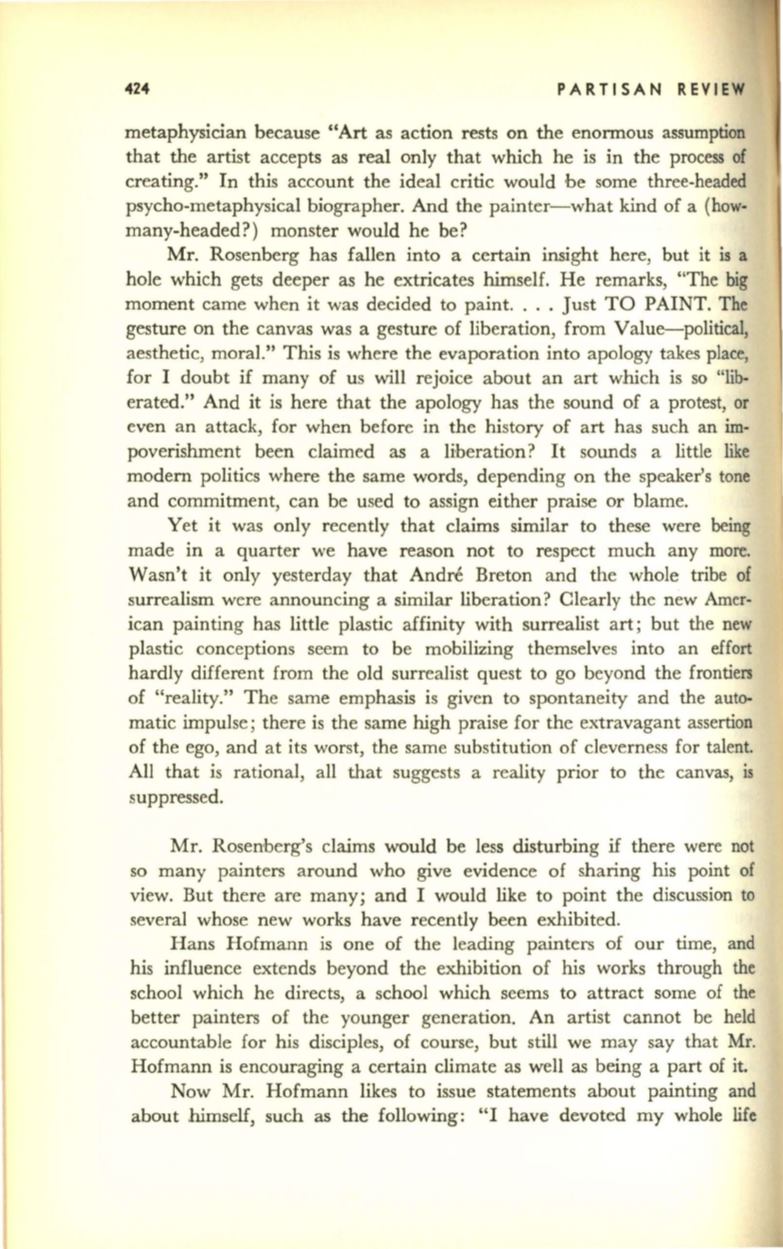
424
PARTISAN REVIEW
metaphysician because "Art as action rests on the enormous assumption
that the artist accepts as real only that which he is in the process of
creating." In this account the ideal critic would be some three-headed
psycho-metaphysical biographer. And the painter-what kind of a (how–
many-headed?) monster would he be?
Mr. Rosenberg has fallen into a certain insight here, but it is a
hole which gets deeper as he extricates himself. He remarks, "The big
moment came when it was decided to paint.. . . Just TO PAINT. The
gesture on the canvas was a gesture of liberation, from Value-political,
aesthetic, moral." This is where the evaporation into apology takes place,
for I doubt if many of us will rejoice about an art which is so "lib–
erated." And it is here that the apology has the sound of a protest, or
even an attack, for when before in the history of art has such an
im–
poverishment been claimed as a liberation? It sounds a little like
modern politics where the same words, depending on the speaker's tone
and commitment, can be used to assign either praise or blame.
Yet it was only recently that claims similar to these were
being
made in a quarter we have reason not to respect much any more.
Wasn't it only yesterday that Andre Breton and the whole tribe of
surrealism were announcing a similar liberation? Clearly the new Amer–
ican painting has little plastic affinity with surrealist art; but the new
plastic conceptions seem to be mobilizing themselves into an effort
hardly different from the old surrealist quest to go beyond the frontiers
of "reality." The same emphasis is given to spontaneity and the auto–
matic impulse; there is the same high praise for the extravagant assertion
of the ego, and at its worst, the same substitution of cleverness for talent.
AlI that is rational, all that suggests a reality prior to the canvas, is
suppressed.
Mr. Rosenberg's claims would be less disturbing if there were not
so many painters around who give evidence of sharing his point of
view. But there are many; and I would like to point the discussion to
several whose new works have recently been exhibited.
Hans Hofmann is one of the leading painters of our time, and
his influence extends beyond the exhibition of his works through the
school which he directs, a school which seems to attract some of the
better painters of the younger generation. An artist cannot be held
accountable for his disciples, of course, but stilI we may say that Mr.
Hofmann is encouraging a certain climate as welI as being a part of it.
Now Mr. Hofmann likes to issue statements about painting and
about himself, such as the following: "I have devoted my whole life


